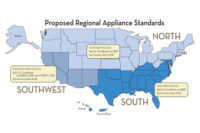As the geothermal industry sets its sights on increasing its commercial market share and promoting its technology, many are concerned about the lack of awareness and understanding among contractors, engineers, architects, and others involved in building construction and maintenance. But there are efforts underway to increase awareness and training to promote familiarity with these systems.
Personnel Standards
In July 2013, “National Certification Standard for Ground Source Heat Pump Personnel” was published as part of an effort to increase the deployment of geothermal heat pump (GHP) systems. The report published personnel certification standards for workers involved in every step of a GHP project.
According to John Kelly, principal investigator at the Geothermal Exchange Organization (GEO), the report was commissioned by the U.S. Department of Energy (DOE), which awarded a grant to GEO to develop the standard. It lists and describes the knowledge and skills needed for 14 jobs related to GHP system design and installation, from project manager to maintenance technician.
DOE’s purpose behind the development of the standard was to overcome the barriers related to lack of knowledge of and confidence in GHP systems. The idea, as stated in the report’s summary, is that a published personnel standard can “increase customer confidence in the technology, reduce the potential for improperly installed systems, and ensure product quality and performance.”
It is also intended to lay the groundwork for future certification efforts.
Kelly noted that the standard was developed by a consensus process that included a variety of industry stakeholders. “The goal of the release of the standard is to make it available to any organization or geothermal heat pump company in their efforts to engage in the geothermal heat pump industry,” he said.
He continued, “Geothermal heat pump contractors can use the report to identify the knowledge, skills, and abilities needed for the various jobs involved in the design and installation of GHP systems, as well as the interdependencies between the jobs.”
Commercial Designer Training
Another new offering designed specifically to bridge the gap in knowledge on the commercial side of the geothermal industry is the Certified Geoexchange Designer (CGD) course from the International Ground Source Heat Pump Association (IGSHPA).
According to Ed Lohrenz, the course developer and instructor, the goal behind the new three-day course and certification program is to improve participants’ familiarity with geothermal so they can design better systems for commercial applications.
Lohrenz has been involved in the geothermal industry for more than 30 years and is the president of GEOptimize, a geothermal consulting firm based in Canada. During his tenure in the industry, he has seen a lot of problems with poorly designed geothermal systems.
For instance, he said, “With a lot of designs that are going to tender now, a client may have asked for a geothermal system, but what they end up getting is a conventional system with a geothermal system strapped onto it.”
He explained that this is due to a lack of familiarity and trust in geothermal systems. “Designers, whether they’re engineers or contractors, need to feel more comfortable with the design. The design of a geothermal system really isn’t any more difficult than designing a conventional HVAC system — it’s different,” he said. “And the big difference is that when you’re designing a ground heat exchanger, you’re designing an energy source for the building.”
Plus, he noted that it’s a common misconception that the ground is an energy source.
“With a ground-source system, you’re dealing with an energy storage system, really, more than an infinite energy source,” he said. “What you’re doing is you’re extracting heat from the ground in the winter, and you’re putting heat back into the ground in the summer. So a lot of what the course is about is learning how to balance the amount of energy coming out of the ground and the amount of energy going in over the year so that you can continue to do this forever.”
To be able to do this, Lohrenz stressed that he teaches a lot about the importance of energy modeling. “Energy modeling is really one of the most important tools that a ground heat exchange designer has at his disposal,” he said. Modeling is particularly helpful when considering what effects different measures will have on the heating and cooling loads, such as upgrading to high-efficiency lighting or windows, he explained.
“To really optimize a geothermal system, you really have to look at the whole building. And after you’ve really tried to optimize the whole building, then you can start to look at designing the ground loop for it,” said Lohrenz.
Rob Jensen, president of Agreenability LLC, took the CGD course at the end of 2013. As the manufacturer of a new geothermal heat exchange product that has been used in residential applications for the past two years, Jensen was seeking to learn more about the commercial side of the industry.
“I absolutely learned something new, especially because my experience is not as great in designing commercial projects,” he said. “I wanted to learn more about what people are doing out there, which is really what the course is focused on. It’s really just to show people what’s possible through innovative approaches.”
Jensen expects his product to be spec’d into commercial projects later this year, and he said he’ll be prepared, thanks to the CGD course. “As I went through that course, I really started understanding what can be achieved and how you can reduce the cost of systems,” he said.
SIDEBAR: Training Providers
Seeking additional knowledge and training on geothermal systems? Check out the following organizations:
• International Ground Source Heat Pump Association (IGSHPA) www.igshpa.okstate.edu
• National Ground Water Association (NGWA) www.ngwa.org
• ASHRAE www.ashrae.org
For a list of state and regional organizations offering training, visit www.geoexchange.org.
Publication date: 3/24/2014
Want more HVAC industry news and information? Join The NEWS on Facebook, Twitter, and LinkedIn today!









